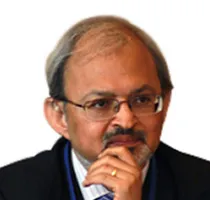-
CENTRES
Progammes & Centres
Location
Rationing of gas makes the development of a unified gas market impossible. This means the prevalence of a dozen price levels confounding all - buyers and sellers, and investors on both sides. The spin-off leaves India struggling with the most poorly developed gas infrastructure.

The Hindu (Making a mockery of domestic gas pricing), its author Surya P. Sethi attacks the gas pricing formula proposed by the Rangarajan Committee, curiously enough, for being based on numbers from foreign markets that do not reflect the supply, demand or cost of production in India.
I say "curiously" because on the exact opposite side, domestic producers are also pillorying the committee's recommendations using exactly the same logic. The musings of the recent 12th Five Year Plan adopted by the NDC again find solace in the fond hope that "Natural Gas prices charged to producers ... must be determined by market forces."
Since all parties are invoking the same God of markets, some basic high school economics is in order. Any market perforce consists of buyers and sellers. One constitutes demand, the other, supply. Prices are fixed at their intersection.
So we have a market price. A price "fixed" by a Committee, or the Government is not called a market price; it is called an administered price.
Mr. Sethi is right in his assertion that the formula suggested by the Rangarajan Committee does not reflect the market price in India but rather the price in foreign markets.
But by that very same logic, producers can argue that the market price perforce has to be the marginal price of the highest cost gas that is being absorbed in the Indian market. This happens to be spot LNG bought and sold between willing buyers and sellers at over $15 per mmbtu. Why should domestic producers, they will argue, be barred from tapping into this market and benefiting from prices willingly paid by buyers in the great Indian market? Is this market reserved only for production from overseas?
Contracts and prices
Actually both Mr. Sethi and the producers, standing on opposite sides of the divide, are wrong for exactly the same reason.
Mr. Sethi, while talking of demand and supply, and the operation of market forces, is really arguing for administered prices that are linked to the cost of production. This is advocating a return to the principles of the APM regime which allowed ONGC and OIL to get a fixed rate of return on all domestic production of oil and gas. The problem with all cost of production linked pricing regimes being that they promote rather than eliminate inefficiencies, something which led to their being jettisoned years ago.
The producers are wrong in using the highest priced LNG as the benchmark and then making a leap of faith to presume that all gas available will be absorbed at the highest marginal price. They too are thus arguing not for a market price but for their own version of an administered price coming from the government.
The only pertinent question in this debate, which all sides miss, is the simple one of whether the legally binding Production Sharing Contracts (PSCs) allow for administered or market prices.
Far removed from all the noise about fiscal deficit and subsidies, all PSCs signed by the government under NELP mandate arm's-length market prices, not prices linked to the cost of production. The provisions apply to all PSC producers including ONGC, OIL and private firms.
All PSCs are constructed on the principle of revenue maximisation - the same principle which gave occasion to the CAG to rub a lot of noses into the ground. Based on this principle, PSCs incorporate clauses of approval to any pricing formula to ensure that contractors do not underprice gas to related parties and siphon away revenues that are part of the contract.
These provisions do not give the government the power to control gas prices to contain its subsidy burden. Just as - in spite of subsidies on kerosene, LPG and diesel - the government must allow international prices for all crude oil being produced under these contracts, it cannot control gas prices to contain subsidies. Beyond the four walls of the contract, the government has every right to fix its priorities. It is free also to abandon the God of markets. But, should it decide that low gas prices are the priority, then all bidding for future oil and gas blocks must be on the basis of lowest prices rather than highest profit share. What it cannot do is to invite bids for revenue maximisation under ring-fenced contracts and then seek to implement, through stealth, the exact opposite. The buzzword in contract administration is transparency and not stealth. The latter can only lead to a few subsidy scams being unearthed by the CAG.
On the market
What prevents the operation of the contract as signed under NELP? The culprit is the Gas Utilisation Policy that fragments the market for gas into a hierarchy of the more favoured, the less favoured, and the discards. Rationing of gas makes the development of a unified gas market impossible. This means the prevalence of a dozen price levels confounding all - buyers and sellers, and investors on both sides. The spin-off leaves India struggling with the most poorly developed gas infrastructure - LNG terminals, transnational and domestic pipelines. Ironically, this perpetuates underdeveloped markets limiting our access to the one fuel that has caught the fancy of the world.
Hence the strange paradox of a Government committee being asked to "administer" a "market price"!
So why blame the hapless committee?
Confronted by the irresolvable dilemma of discovering the market price for a market rendered dysfunctional by policy, the good economist, Dr. Rangarajan, takes the weighted average of prices across functioning gas markets in the world and recommends that the result be applied to India. Does he, in the process, arrive at the "true" market price in India? No, he certainly does not - and to be fair, the committee admits as much by suggesting that we move to gas-on-gas competition within the next five years. Where it fails is in not even attempting to give/suggest a path that can make this possible.
If Mr. Sethi is right, the market price could be far lower than what the committee recommends. Or the producers may yet have the last laugh. But no committee or professional (no matter how competent) can ever second-guess the market. Let it alone decide which of the several parties advocating its version of administered prices is the one wanting to eat its cake and have it too.
(Sunjoy Joshi is the Director, Observer Research Foundation, New Delhi)
Courtesy: The Hindu,
The views expressed above belong to the author(s). ORF research and analyses now available on Telegram! Click here to access our curated content — blogs, longforms and interviews.

Sunjoy Joshi has a Master’s Degree in English Literature from Allahabad University, India, as well as in Development Studies from University of East Anglia, Norwich. ...
Read More +